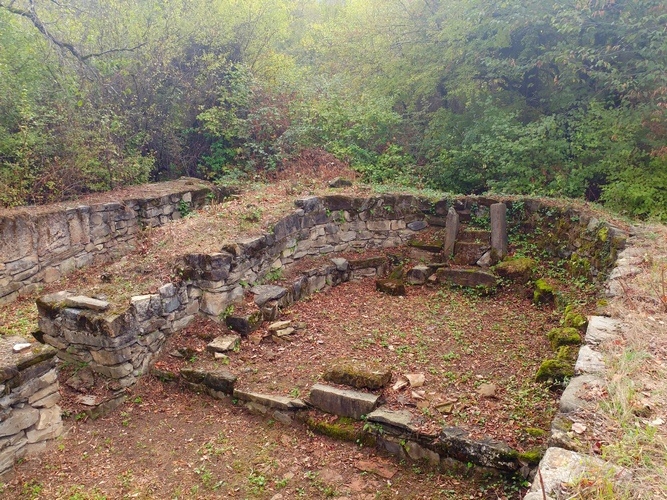Chabukauri Basilica on:
[Wikipedia]
[Google]
[Amazon]
Chabukauri basilica ( ka, ჭაბუკაურის ბაზილიკა, tr) is an early Christian church—now in a ruinous state—in the eastern
 Chabukauri is a three-
Chabukauri is a three-
Georgian
Georgian may refer to:
Common meanings
* Anything related to, or originating from Georgia (country)
** Georgians, an indigenous Caucasian ethnic group
** Georgian language, a Kartvelian language spoken by Georgians
**Georgian scripts, three scrip ...
region of Kakheti, in the territory of the historical settlement of Nekresi
Nekresi ( ka, ნეკრესი) is a historic and archaeological site in eastern Georgian region of Kakheti, between the town of Qvareli and the village of Shilda, at the foothills of the Greater Caucasus mountains. It is home to the still-fu ...
, about 1.5 km northwest of the Nekresi monastic complex. It is a large three-aisle basilica, dated to the 4th to 5th century, making it one of the earliest Christian church buildings in Georgia. It was unearthed in 1998. The basilica is inscribed on the list of the Immovable Cultural Monuments of National Significance The Immovable Cultural Monuments of National Significance ( ka, ეროვნული მნიშვნელობის კატეგორიის კულტურის უძრავი ძეგლები) are buildings, structures ...
of Georgia.
History
The Chabukauri basilica was unearthed in an eponymous plot in 1998 and was dated, on architectural and archaeological grounds, to the 4th or 5th century. Being one of the largest basilican churches in Georgia, its discovery questioned a previous assumption that the first church buildings in eastern Georgia were typically small narrow edifices autonomously developed in the country. Another huge basilica, the Dolochopi church, was uncovered just 4 km east as the crow flies, in 2012. Both temples appear to have been part of the larger settlement of Nekresi, but due to the lack of written sources and dense foliage covering the area its extent remains unknown. These Christian establishments were founded not long after as a nearby locatedZoroastrian
Zoroastrianism is an Iranian religion and one of the world's oldest organized faiths, based on the teachings of the Iranian-speaking prophet Zoroaster. It has a dualistic cosmology of good and evil within the framework of a monotheistic ...
shrine, the so-called Nekresi fire temple
The Nekresi fire temple ( ka, ნეკრესის ცეცხლის ტაძარი, tr) is an archaeological complex in the eastern Georgian region of Kakheti, part of the wider Nekresi site. The excavated building, preserved only fra ...
, was abandoned. Nodar Bakhtadze, who excavated Chabukauri, identifies the basilica with a church known from the early medieval Georgian chronicles to have been founded at Nekresi by King Trdat of Kartli (). The church's design is in line with the established Eastern Roman
The Byzantine Empire, also referred to as the Eastern Roman Empire or Byzantium, was the continuation of the Roman Empire primarily in its eastern provinces during Late Antiquity and the Middle Ages, when its capital city was Constantinopl ...
standards, but the architectural details such as a quadrangular sanctuary and parabemata show affinities with the early churches in Sasanian Iran
The Sasanian () or Sassanid Empire, officially known as the Empire of Iranians (, ) and also referred to by historians as the Neo-Persian Empire, was the last Iranian empire before the early Muslim conquests of the 7th-8th centuries AD. Named ...
, such as Hira, Ain Shaia, and Kharg, all dated to the late 4th century.
Layout
 Chabukauri is a three-
Chabukauri is a three-nave
The nave () is the central part of a church, stretching from the (normally western) main entrance or rear wall, to the transepts, or in a church without transepts, to the chancel. When a church contains side aisles, as in a basilica-type ...
basilica, measuring 33.4 x 15 m. It was built of large limestone blocks, sledged stones, and gravel. The naos is divided into three naves by five pairs of rectangular-shaped pillars. A rectangular altar seems to have been placed in the southeast of the main nave. It was flanked, on either side, by small rectangular chambers, corresponding to the pastophoria Pastophorion ( el, παστοφόριον, translit=pastophorium) is one of two chambers within an early Christian and Eastern Christian church building used as sacristies—the diakonikon and the prothesis.
Originally, in the Greek Old Testament ...
. The building had three entrances, on the south, west, and north. The main nave appears to have been damaged in an earthquake not long after the church's construction and part of its northeastern sector was converted into the south aisle of a new, smaller building. This new church terminated in two distinctive horseshoe-shaped apses, the larger of which had a synthronon. The church had a wooden roof with ceramic tiles, held in place with nails and antefixes. A number of medieval cist
A cist ( or ; also kist ;
from grc-gre, κίστη, Middle Welsh ''Kist'' or Germanic ''Kiste'') is a small stone-built coffin-like box or ossuary used to hold the bodies of the dead. Examples can be found across Europe and in the Middle Ea ...
burials have been unearthed across the site. Within the church ruins, many fragments of pottery and two unique bronze oil lamps have been found. To the northwest of the basilica there is a small apsed structure of unknown function, which was covered by a high-quality terracotta tile floor. There is an indication that the walls of the building were once plastered and painted red.
References
{{reflist Buildings and structures in Kakheti Immovable Cultural Monuments of National Significance of Georgia 4th-century churches 1998 archaeological discoveries Archaeological sites in Georgia (country)